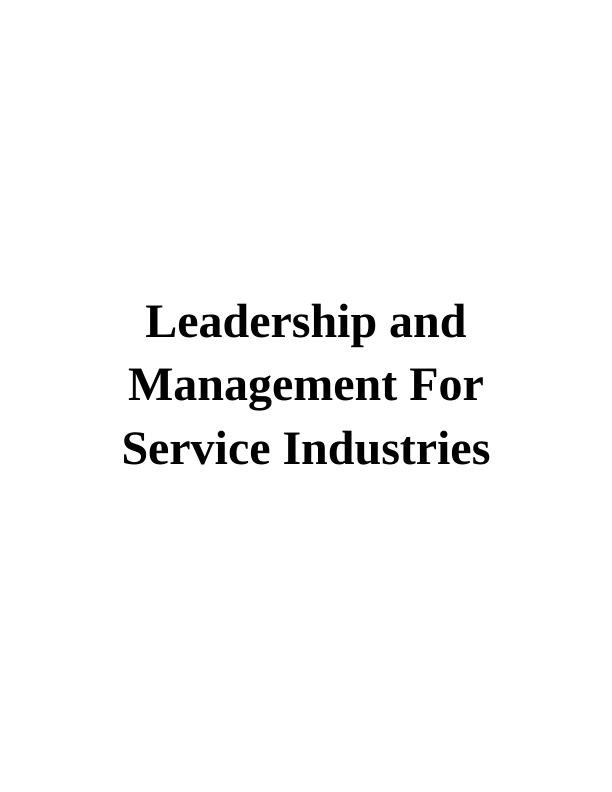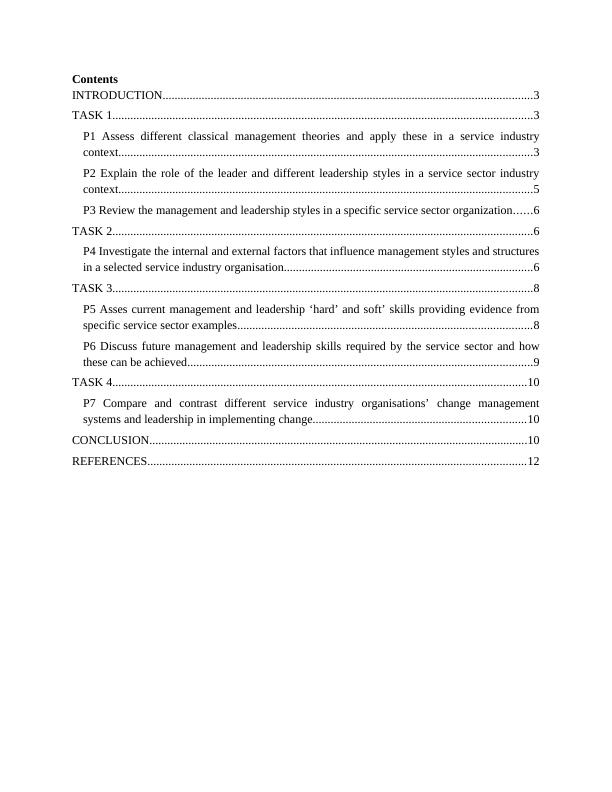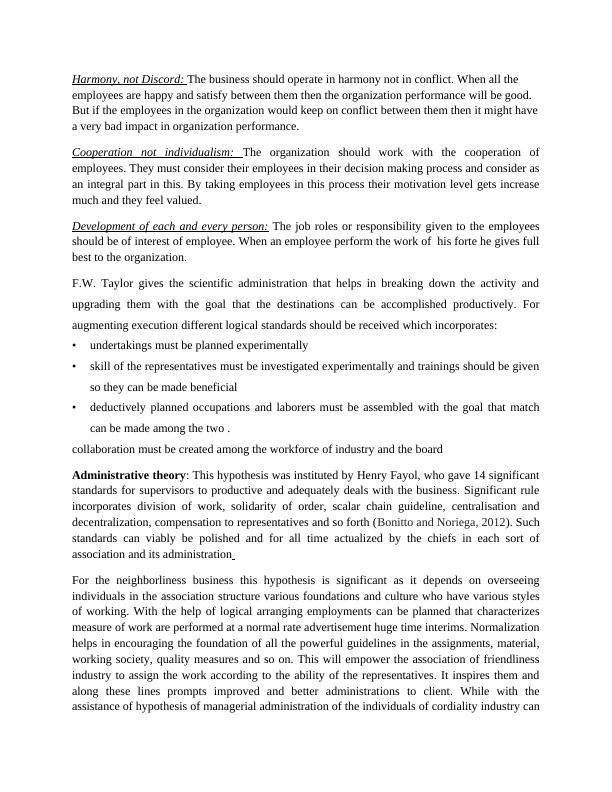Leadership and Management For Service Industries
Added on 2023-01-12
13 Pages5127 Words58 Views
Leadership and
Management For
Service Industries
Management For
Service Industries

Contents
INTRODUCTION...........................................................................................................................3
TASK 1............................................................................................................................................3
P1 Assess different classical management theories and apply these in a service industry
context..........................................................................................................................................3
P2 Explain the role of the leader and different leadership styles in a service sector industry
context..........................................................................................................................................5
P3 Review the management and leadership styles in a specific service sector organization......6
TASK 2............................................................................................................................................6
P4 Investigate the internal and external factors that influence management styles and structures
in a selected service industry organisation...................................................................................6
TASK 3............................................................................................................................................8
P5 Asses current management and leadership ‘hard’ and soft’ skills providing evidence from
specific service sector examples..................................................................................................8
P6 Discuss future management and leadership skills required by the service sector and how
these can be achieved...................................................................................................................9
TASK 4..........................................................................................................................................10
P7 Compare and contrast different service industry organisations’ change management
systems and leadership in implementing change.......................................................................10
CONCLUSION..............................................................................................................................10
REFERENCES..............................................................................................................................12
INTRODUCTION...........................................................................................................................3
TASK 1............................................................................................................................................3
P1 Assess different classical management theories and apply these in a service industry
context..........................................................................................................................................3
P2 Explain the role of the leader and different leadership styles in a service sector industry
context..........................................................................................................................................5
P3 Review the management and leadership styles in a specific service sector organization......6
TASK 2............................................................................................................................................6
P4 Investigate the internal and external factors that influence management styles and structures
in a selected service industry organisation...................................................................................6
TASK 3............................................................................................................................................8
P5 Asses current management and leadership ‘hard’ and soft’ skills providing evidence from
specific service sector examples..................................................................................................8
P6 Discuss future management and leadership skills required by the service sector and how
these can be achieved...................................................................................................................9
TASK 4..........................................................................................................................................10
P7 Compare and contrast different service industry organisations’ change management
systems and leadership in implementing change.......................................................................10
CONCLUSION..............................................................................................................................10
REFERENCES..............................................................................................................................12

INTRODUCTION
Leadership and management refer to the process of influencing the individuals to make
them work towards the direction shown by you for the attainment of the desired goals and
objectives. A leader is a person who sets the vision and mission for its organization. Whereas
management refers to planning, organizing, staffing, directing and controlling the activities or
operations in an organization. The functions of a manager is planning, organizing the resources,
staffing the people, giving directions to the people and controlling measures for bridging the
between the actual and standard objectives. Service industries are those which satisfies the needs
and wants of people through intangible products. Services can’t be see, touch or felt. They are
intangible products which gets perishable when the services get consumed by the customers. For
reference purpose this report has taken an example of a Hotel Holiday inn. Holiday inn is a
British multinational hotel chain which is at number one at hotel chain. The company have any
hotel and residential inn for accommodation (Aghashahi and et. al., 2013). The holiday inn
serves throughout the world.
This report discusses about the different classical management theories and applies these
in service industry content. The report also includes the different types of leadership style,
internal and external factors which influences the leadership style. Apart from this the report also
discusses about the comparison and contrast of different service industry organizations’ change
management system and leadership in implementing change.
TASK 1
P1 Assess different classical management theories and apply these in a service industry context
Management performs various functions which include planning, organizing, staffing,
directing and controlling. There are many theories; modern as well as classical theories which
state some principles about how management should be perform. The great contribution in
classical theories of management was given by F.W. Taylor who proposes scientific theory for
management. The various classical management theories are as follows:
Scientific management: This theory was proposed by F.W. Taylor. The principles of this theory
are as follows:
Science, Not rule of thumb: In this principle the use of scientific method has been put at focus.
The principle says that the organization should adopt the science or scientific technique behind
their operations or activities. The activities or operations should not be set on trial and error
method, which is said to be a costly affair. The scientific method helps the business in perform
their activities in much reasonable manner that they does not have to perform hit and trial
method. When the things are performed in a proper and reasonable way they might work
profitable for business (Birasnav, 2014).
Leadership and management refer to the process of influencing the individuals to make
them work towards the direction shown by you for the attainment of the desired goals and
objectives. A leader is a person who sets the vision and mission for its organization. Whereas
management refers to planning, organizing, staffing, directing and controlling the activities or
operations in an organization. The functions of a manager is planning, organizing the resources,
staffing the people, giving directions to the people and controlling measures for bridging the
between the actual and standard objectives. Service industries are those which satisfies the needs
and wants of people through intangible products. Services can’t be see, touch or felt. They are
intangible products which gets perishable when the services get consumed by the customers. For
reference purpose this report has taken an example of a Hotel Holiday inn. Holiday inn is a
British multinational hotel chain which is at number one at hotel chain. The company have any
hotel and residential inn for accommodation (Aghashahi and et. al., 2013). The holiday inn
serves throughout the world.
This report discusses about the different classical management theories and applies these
in service industry content. The report also includes the different types of leadership style,
internal and external factors which influences the leadership style. Apart from this the report also
discusses about the comparison and contrast of different service industry organizations’ change
management system and leadership in implementing change.
TASK 1
P1 Assess different classical management theories and apply these in a service industry context
Management performs various functions which include planning, organizing, staffing,
directing and controlling. There are many theories; modern as well as classical theories which
state some principles about how management should be perform. The great contribution in
classical theories of management was given by F.W. Taylor who proposes scientific theory for
management. The various classical management theories are as follows:
Scientific management: This theory was proposed by F.W. Taylor. The principles of this theory
are as follows:
Science, Not rule of thumb: In this principle the use of scientific method has been put at focus.
The principle says that the organization should adopt the science or scientific technique behind
their operations or activities. The activities or operations should not be set on trial and error
method, which is said to be a costly affair. The scientific method helps the business in perform
their activities in much reasonable manner that they does not have to perform hit and trial
method. When the things are performed in a proper and reasonable way they might work
profitable for business (Birasnav, 2014).

Harmony, not Discord: The business should operate in harmony not in conflict. When all the
employees are happy and satisfy between them then the organization performance will be good.
But if the employees in the organization would keep on conflict between them then it might have
a very bad impact in organization performance.
Cooperation not individualism: The organization should work with the cooperation of
employees. They must consider their employees in their decision making process and consider as
an integral part in this. By taking employees in this process their motivation level gets increase
much and they feel valued.
Development of each and every person: The job roles or responsibility given to the employees
should be of interest of employee. When an employee perform the work of his forte he gives full
best to the organization.
F.W. Taylor gives the scientific administration that helps in breaking down the activity and
upgrading them with the goal that the destinations can be accomplished productively. For
augmenting execution different logical standards should be received which incorporates:
• undertakings must be planned experimentally
• skill of the representatives must be investigated experimentally and trainings should be given
so they can be made beneficial
• deductively planned occupations and laborers must be assembled with the goal that match
can be made among the two .
collaboration must be created among the workforce of industry and the board
Administrative theory: This hypothesis was instituted by Henry Fayol, who gave 14 significant
standards for supervisors to productive and adequately deals with the business. Significant rule
incorporates division of work, solidarity of order, scalar chain guideline, centralisation and
decentralization, compensation to representatives and so forth (Bonitto and Noriega, 2012). Such
standards can viably be polished and for all time actualized by the chiefs in each sort of
association and its administration
For the neighborliness business this hypothesis is significant as it depends on overseeing
individuals in the association structure various foundations and culture who have various styles
of working. With the help of logical arranging employments can be planned that characterizes
measure of work are performed at a normal rate advertisement huge time interims. Normalization
helps in encouraging the foundation of all the powerful guidelines in the assignments, material,
working society, quality measures and so on. This will empower the association of friendliness
industry to assign the work according to the ability of the representatives. It inspires them and
along these lines prompts improved and better administrations to client. While with the
assistance of hypothesis of managerial administration of the individuals of cordiality industry can
employees are happy and satisfy between them then the organization performance will be good.
But if the employees in the organization would keep on conflict between them then it might have
a very bad impact in organization performance.
Cooperation not individualism: The organization should work with the cooperation of
employees. They must consider their employees in their decision making process and consider as
an integral part in this. By taking employees in this process their motivation level gets increase
much and they feel valued.
Development of each and every person: The job roles or responsibility given to the employees
should be of interest of employee. When an employee perform the work of his forte he gives full
best to the organization.
F.W. Taylor gives the scientific administration that helps in breaking down the activity and
upgrading them with the goal that the destinations can be accomplished productively. For
augmenting execution different logical standards should be received which incorporates:
• undertakings must be planned experimentally
• skill of the representatives must be investigated experimentally and trainings should be given
so they can be made beneficial
• deductively planned occupations and laborers must be assembled with the goal that match
can be made among the two .
collaboration must be created among the workforce of industry and the board
Administrative theory: This hypothesis was instituted by Henry Fayol, who gave 14 significant
standards for supervisors to productive and adequately deals with the business. Significant rule
incorporates division of work, solidarity of order, scalar chain guideline, centralisation and
decentralization, compensation to representatives and so forth (Bonitto and Noriega, 2012). Such
standards can viably be polished and for all time actualized by the chiefs in each sort of
association and its administration
For the neighborliness business this hypothesis is significant as it depends on overseeing
individuals in the association structure various foundations and culture who have various styles
of working. With the help of logical arranging employments can be planned that characterizes
measure of work are performed at a normal rate advertisement huge time interims. Normalization
helps in encouraging the foundation of all the powerful guidelines in the assignments, material,
working society, quality measures and so on. This will empower the association of friendliness
industry to assign the work according to the ability of the representatives. It inspires them and
along these lines prompts improved and better administrations to client. While with the
assistance of hypothesis of managerial administration of the individuals of cordiality industry can

End of preview
Want to access all the pages? Upload your documents or become a member.
Related Documents
Leadership and Management for Service Industrieslg...
|10
|2760
|238
Leadership and Management for Service Industrylg...
|15
|4793
|33
Leadership and Management Styles in Premier Inn London Country Hall Hotellg...
|14
|4700
|73
Leadership and Management for Service Industrieslg...
|15
|3808
|376
Leadership and Management for Service Industries (pdf)lg...
|10
|2341
|328
Leadership and Management for Service Industries PDFlg...
|16
|5315
|147
